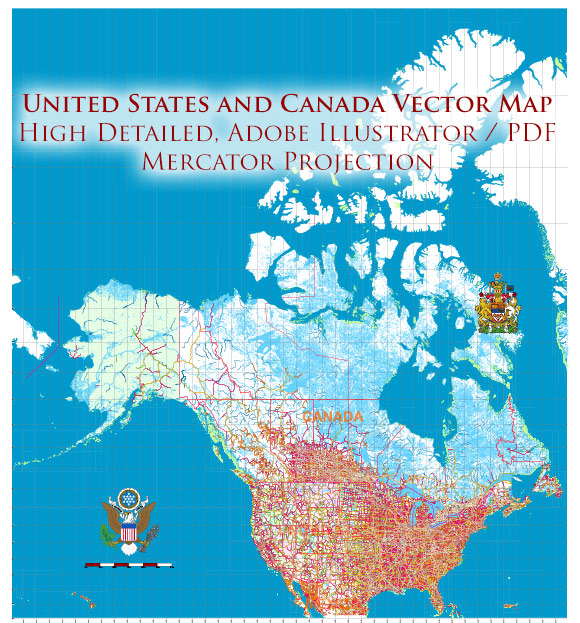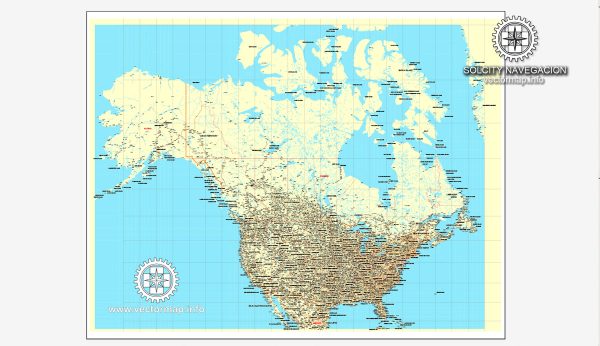A general overview of the infrastructure in the United States and Canada. Vectormap.Net provide you with the most accurate and up-to-date vector maps in Adobe Illustrator, PDF and other formats, designed for editing and printing. Please read the vector map descriptions carefully.
United States Infrastructure:
- Transportation:
- Roads and Highways: The U.S. has an extensive network of roads and highways, including a vast interstate system.
- Airports: The country has numerous airports, including major international hubs.
- Railways: The U.S. has an extensive railway network, primarily for freight transport.
- Energy:
- Electricity Grid: The United States has a complex and interconnected electrical grid.
- Renewable Energy: There has been a growing focus on renewable energy sources such as wind and solar power.
- Telecommunications:
- Broadband Infrastructure: The U.S. has widespread broadband coverage, but there are ongoing efforts to improve access in rural and underserved areas.
- Water and Sewage:
- Water Supply and Treatment: The U.S. has well-developed water supply and treatment systems.
- Wastewater Treatment: Facilities exist to treat and manage wastewater.
- Public Facilities:
- Education: The U.S. has a diverse education infrastructure, including schools, colleges, and universities.
- Healthcare: The healthcare system includes a variety of facilities ranging from clinics to advanced medical centers.
- Digital Infrastructure:
- Data Centers: The U.S. hosts a significant number of data centers, supporting the digital economy.
- Internet Connectivity: The country has a robust internet infrastructure.
Canada Infrastructure:
- Transportation:
- Roads and Highways: Canada has an extensive road network, including the Trans-Canada Highway.
- Airports: Major international airports are located in cities across the country.
- Railways: Rail transport, particularly for freight, is significant.
- Energy:
- Electricity Grid: Canada’s electricity grid serves a vast and geographically diverse landscape.
- Natural Resources: The country is rich in natural resources, including hydroelectric power and oil.
- Telecommunications:
- Broadband Infrastructure: Efforts are ongoing to improve broadband access, particularly in rural areas.
- Water and Sewage:
- Water Supply and Treatment: Canada has well-established water treatment facilities.
- Wastewater Treatment: Systems are in place for wastewater management.
- Public Facilities:
- Education: Canada has a comprehensive education system, including universities known for research and innovation.
- Healthcare: The healthcare system is publicly funded and provides universal coverage.
- Digital Infrastructure:
- Internet Connectivity: Canada has a strong internet infrastructure, and efforts are made to expand high-speed internet access, especially in remote areas.
Both countries continually invest in infrastructure development to support economic growth and improve the quality of life for their citizens. For the most current information, it is recommended to refer to official government sources and infrastructure-related organizations in each country.








 Author: Kirill Shrayber, Ph.D.
Author: Kirill Shrayber, Ph.D.